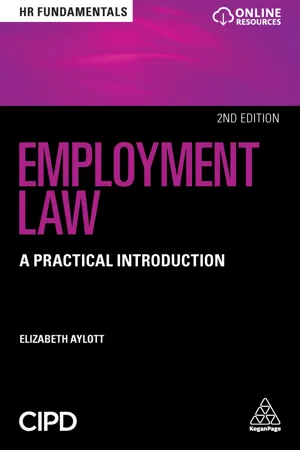
- English
- ePUB (mobile friendly)
- Available on iOS & Android
About this book
To many, the world of employment law and seem complex and confusing. But, this important system that regulates the relationship between employers and employees is essential to understand. Employment Law is a clear and practical guide to understanding and applying the law effectively at work in the UK. It offers a complete overview of the fundamentals of employment law, exploring its importance for an organization, its employees and the HR function. Using a combination of practical tools, checklists, case studies and real-life examples, it builds legal knowledge in key areas including recruitment, contracts, discrimination, equal pay, health and safety and managing the end of the employment relationship.This fully revised second edition of Employment Law is updated to include the latest developments and changes in law and HR perspectives. It contains new material on employment statuses, Gender Pay Gap Reporting, Shared Parental Leave, the General Data Protection Regulation (GDPR), and disability discrimination, which is supported by updated case studies and a suite of new online resources. HR Fundamentals is a series of succinct, practical guides for students and those in the early stages of their HR careers. They are endorsed by the Chartered Institute of Personnel and Development (CIPD), the UK professional body for HR and people development, which has over 145,000 members worldwide.
Frequently asked questions
- Essential is ideal for learners and professionals who enjoy exploring a wide range of subjects. Access the Essential Library with 800,000+ trusted titles and best-sellers across business, personal growth, and the humanities. Includes unlimited reading time and Standard Read Aloud voice.
- Complete: Perfect for advanced learners and researchers needing full, unrestricted access. Unlock 1.4M+ books across hundreds of subjects, including academic and specialized titles. The Complete Plan also includes advanced features like Premium Read Aloud and Research Assistant.
Please note we cannot support devices running on iOS 13 and Android 7 or earlier. Learn more about using the app.
Information
PART ONE
FUNDAMENTALS
01
What is employment law?
- the sources of domestic and European law (with reference to Brexit);
- the relevant structure of the Civil Courts and the Employment Tribunal system;
- the role of law in distributing social justice and ensuring fairness;
- the effect of regulation on the economy, employees, employers and society;
- the Employment Tribunal process and out-of-court settlements.
Employment law
- health and safety legislation;
- individual employment legislation;
- collective employment legislation.
Domestic law
Statute
Case law
Codes of Practice
European law
In context – social justice and fairness
- the right to association and collective bargaining;
- the elimination of child labour and all forced labour;
- the elimination of discrimination.
Table of contents
- Cover
- Title Page
- Copyright
- Contents
- List of Figures
- List of Tables
- About the author
- Introduction
- PART ONE Fundamentals
- PART TWO In practice
- References and further reading
- Cases and legislation
- Index of case studies
- Index
- Backcover
